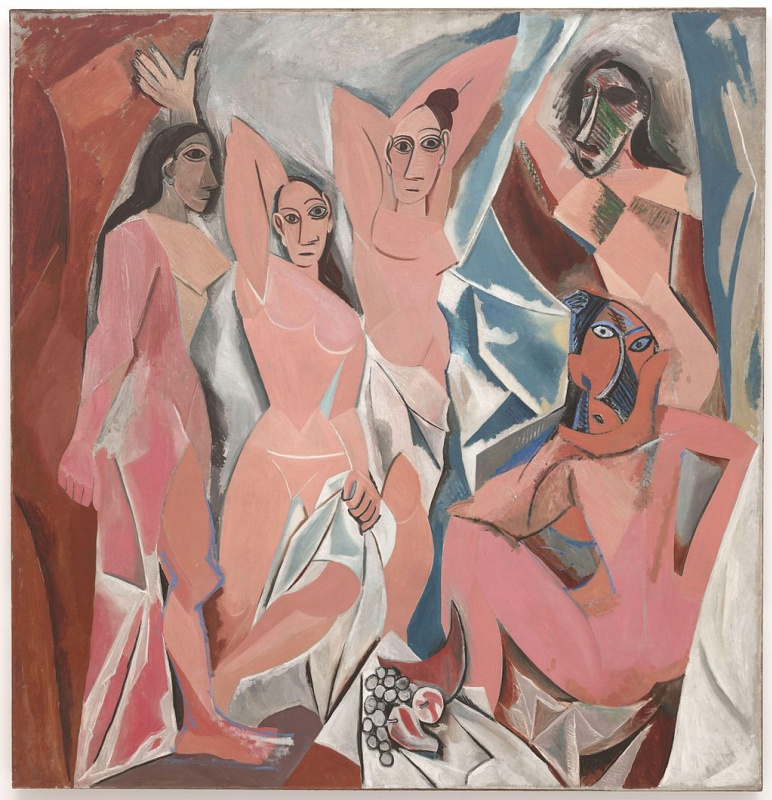log in
Enter site
Login to use Arthive functionality to the maximum
Les demoiselles d'Avignon
Pablo Picasso • Painting, 1907, 243.9×233.7 cm
Description of the artwork «Les demoiselles d'Avignon»
There are hardly many artists who have drastically changed their style at one moment. Most often, there is a certain transitional period, during which the works combine different techniques and styles. Les Demoiselles d'Avignon (The Young Ladies of Avignon) by Picasso is one of those pictures. On the one hand, this is practically cubism in its purest form, but at the same time, the faces of the figures have an undeniable resemblance to masks, which was characteristic of The African Period in the artist's work.
It took nine years for Picasso to complete Les Demoiselles d'Avignon. He made many studies for this canvas (1, 2, 3, 4), which initially had the male figures of the brothel’s regulars in addition to naked women. At first, the picture was called Brothel in Avignon . According to Picasso, he named it that way in memory of the time when he lived near the red lights quarter in Barcelona - Carrer d'Avingo. “Oddly enough,” the artist recalled, “there I found the only shop selling paper and watercolors at a low price.”
In 1916, the art critic André Salmon organized Picasso’s exhibition, at which this painting was presented to the public for the first time. He came up with a new, more decent name for the canvas. And even nine years after its creation, the painting was called immoral. The audience was struck not only by the shameless nudity of the women depicted on the canvas, but also by Picasso's refusal from the generally accepted painting canons. He distorted the faces and bodies of his subjects, breaking them into fragments with various geometric shapes. The artist challenged the usual norms of the idealized image of the female body as something exceptionally beautiful. The women on the canvas seem to be frozen in fear, as if they are trying to separate one from another as much as possible. They are rather focused on the viewer, they look directly at you. Their faces that are painted in different styles and asymmetrical eyes only increase the magnetic power of their gazes and finally nullify the eroticism of the scene.
It took nine years for Picasso to complete Les Demoiselles d'Avignon. He made many studies for this canvas (1, 2, 3, 4), which initially had the male figures of the brothel’s regulars in addition to naked women. At first, the picture was called Brothel in Avignon . According to Picasso, he named it that way in memory of the time when he lived near the red lights quarter in Barcelona - Carrer d'Avingo. “Oddly enough,” the artist recalled, “there I found the only shop selling paper and watercolors at a low price.”
In 1916, the art critic André Salmon organized Picasso’s exhibition, at which this painting was presented to the public for the first time. He came up with a new, more decent name for the canvas. And even nine years after its creation, the painting was called immoral. The audience was struck not only by the shameless nudity of the women depicted on the canvas, but also by Picasso's refusal from the generally accepted painting canons. He distorted the faces and bodies of his subjects, breaking them into fragments with various geometric shapes. The artist challenged the usual norms of the idealized image of the female body as something exceptionally beautiful. The women on the canvas seem to be frozen in fear, as if they are trying to separate one from another as much as possible. They are rather focused on the viewer, they look directly at you. Their faces that are painted in different styles and asymmetrical eyes only increase the magnetic power of their gazes and finally nullify the eroticism of the scene.
According to art critics, Picasso painted Les Demoiselles d'Avignon under the influence of the several works of his colleagues at once: the most often mentioned are Matisse’s Joy of life, Cezanne’s Bathers, Ingres' Turkish Bath, The Opening of the Fifth Seal" by El Greco and Gauguin's Oviri sculpture. In turn, Les Demoiselles d'Avignon impressed Georges Braque Georges Braque, whom Picasso met in 1907. This work marked the beginning of not only a long-term friendship between the two founders of Cubism, but also a triumphal march of an extremely contradictory art movement in Europe.
Written by Evgheniya Sidelnikova
Written by Evgheniya Sidelnikova



